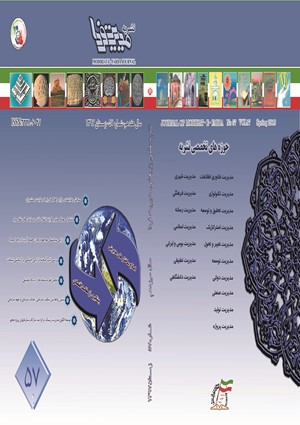Impact of privatization through exchange on the performance of banks in interest-free banking system based on economic resistive criteria
Subject Areas :1 , Mohammad Nasr Isfahani 2 , Mahmood Pirzadi 3
1 -
2 -
3 -
Keywords: private bank, privatization, stock exchange, FANP,
Abstract :
After Islamic Revolution in Iran, all private banks were announced public based on Article 44 of the constitution. Accordingly, all private banks were replaced by public integrated banking system. However, establishment of credit financial institutions since1997 paved the way to establish private banks. Finally, central bank announced its agreement for establishment of private banks in February 1998. In April 2000, the law of establishment of non-public banks was passed. In this study, the performance of private banks during 2005 to 2015 was assessed to investigate their failure or success. Additionally, using the Delphi method and investigation of balance sheet of banks, a comprehensive reportwas obtained from status of privatebanks and the impact of privatization on the banking indicators was examined. The results of assessment of balance sheets and obtained data obtained show privatization of banks had a positive impact on efficiency and profitability of banks.In addition, according to the results, "Premium Features" of private banks compared to public banks includedreducedtotal costs of money, reducedoutstanding loans and doubtful debts of the bank, reduced gap between the interest rate paid on deposits and interest received from a given facilities, updating and creating a modern information structure of banking, providing new service, increased productivity of human resources, using specialists and educated manpower, increased profitability, creating a competitive environment and transparency of information, reduced reliance on central bank at deficits times, and management of risk.In addition, by using the Delphi technique, "Top Premium Features" of private banks compared to public banks were obtained and they were weighted using FANP method. Accordingly, four criteria of reduced total costs of money, reducedoutstanding loans and debts, creating a competitive environment and increased productivity of human resources had the highest weights, respectively.
1. امیدی نژاد محمد، طیبی سید کمیل، مطهری نژاد عباس، 1388، مقایسه کارایی بانک¬های خصوصی با بانک¬های دولتی به روش پارامتری، فصل نامه پژوهش های اقتصادی، سال سیزدهم، شماره 21، ص 1-28
2. بهادری، فاطمه (1395) نقش بانکها در اقتصاد مقاومتی، وزنامه دنیای اقتصاد - شماره 3757، کد خبر: DEN-1051068
3. مظلومپور، محمدرضا (1395) نقش بانکها در اقتصاد مقاومتی، وزنامه دنیای اقتصاد - شماره 3757، کد خبر: DEN-1051068
4. دامغانیان، جمال (1394) نقش و جايگاه سيستم بانكي در اقتصادمقاومتي، خبرگزاری تابناک، کد خبر: ۵۴۲۹۳۶
5. رسول اف جلال، 1389، نوسازی نظام بانکی و توسعه بانکداری خصوصی، مجموعه مقالات بانکداری اسلامی، شماره 19
6. عسگری محمد رضا، مرادیان هاجر، 1392،ارزیابی عملکرد بانک های تازه خصوصی شده، مجموعه مقالات بانکداری اسلامی، صص48-57
7. لشکری محمد، هژبرالساداتی مرتضی، 1389، خصوصی سازی بانک¬ها و تاثیرات آن بر افزایش کارایی و بهبود عملکرد بانک¬ها، مجله راهبرد یاس، شماره 23
8. ناجی میدانی علی اکبر، چمانه گیر فرشته، حسینی زاده بحرینی محمد حسین، 1387، مقایسه کارایی اقتصادی بانک¬های خصوصی و دولتی در ایران با استفاده از روش تحلیلی پوششی داده¬ها، مجلة دانش و توسعه (علمي پژوهشي) سال پانزدهم، شمارة 25
9. جف تان، ترجمه صفار محمد، 1394، خصوصی سازی در مالزی( نظارت، رانت جویی و شکست سیاستی)، انتشارات تهران، چاپ اول، ص403
10. آل عمران سید علی و رویا، 1390، خصوصی سازی و سیاست های کلی اصل 44 قانون اساسی، مجله اقتصادی، ماهنامه ¬بررسی¬ مسائل¬ و ¬سیاست های اقتصادی ، شماره 12 ، صفحات73-88
11. متقیان فیروزه ، راحتی فریبرز، طلائی علی، 1394، بانکداری اسلامی و اقتصاد مقاومتی ، سایت اطلاع رسانی و خدمات الکترونیک صدا و سیمای جمهوری اسلامی
12. مردانی محمدرضا، 1395، بانکداری اسلامی؛ رهیافت عملی در تحقق اقتصاد مقاومتی، روزنامه دنیای اقتصاد، شماره 3881
13. Najia Saqib , Banking sector liberalization and economic, growth: case study of Pakistan
14. Chunxi Jiang, Shujie Yao, Genfu Feng , Bank Ownership, Privatization, and Performance: Evidence from a Transition Country
15. Cornett, M.M., Guo, L., Khaksari, S., Tehranian, H. (2010), “The Impact of State Ownership on Performance Differences in Privately-Owned Versus State-Owned Banks: An International Comparison”. Journal of Financial Intermediation,


